Symbolism in apocalyptic fiction enhances narratives by creating deeper meanings and emotional connections. This article explores how symbolism reflects societal fears, varies across cultures, and conveys themes through character representations and settings. It also examines psychological responses and the role of unique symbols in enriching interpretations within the genre.
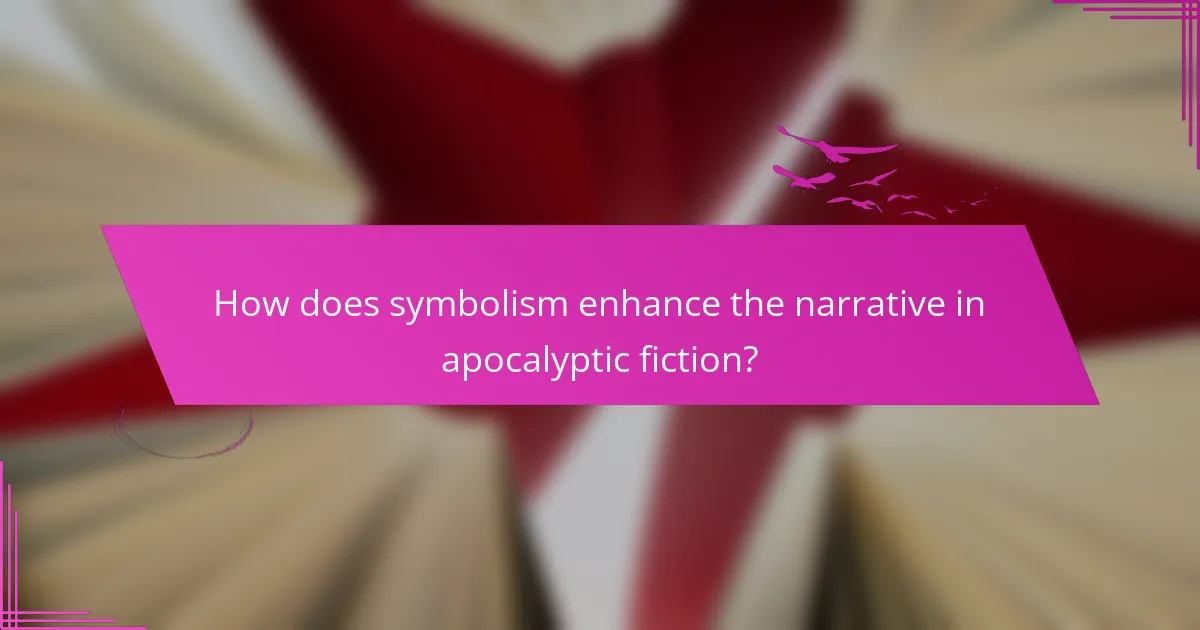
How does symbolism enhance the narrative in apocalyptic fiction?
Symbolism enhances the narrative in apocalyptic fiction by creating deeper meanings and emotional connections. It allows authors to reflect societal fears and existential themes through tangible symbols. For example, a crumbling cityscape may represent the collapse of civilization, while a lone survivor signifies hope and resilience. These symbols invite readers to interpret the underlying messages, fostering engagement and reflection. Additionally, unique symbols can differentiate works within the genre, enriching the reading experience and providing varied interpretations. Through symbolism, apocalyptic fiction becomes a powerful medium for exploring human nature and societal issues.
What are the common symbols used in apocalyptic narratives?
Common symbols in apocalyptic narratives include destruction, rebirth, and the end of civilization. These symbols convey themes of loss, hope, and transformation. For example, fire often represents purification, while water signifies renewal. Additionally, the presence of darkness frequently symbolizes despair, contrasting with light that embodies hope. Characters like the savior or the fallen hero illustrate humanity’s struggle and resilience. These symbols enrich narratives, deepening their emotional impact and philosophical inquiries.
How do symbols convey themes of hope and despair?
Symbols in apocalyptic fiction often represent themes of hope and despair simultaneously. For instance, a once-vibrant city skyline may evoke despair due to destruction, while a single flower growing through the cracks symbolizes hope. These contrasting symbols illustrate the struggle between survival and loss. The use of such imagery reinforces the emotional landscape, allowing readers to navigate complex feelings about humanity’s future. By intertwining symbols of hope and despair, authors deepen the narrative, making the exploration of human resilience more poignant.
Why is the use of color significant in apocalyptic symbolism?
The use of color in apocalyptic symbolism is significant as it conveys emotional depth and thematic resonance. Colors often represent various states of being, such as despair, hope, or chaos. For example, red can symbolize violence or destruction, while green may represent rebirth or renewal. This duality allows authors to evoke complex feelings and interpretations. Additionally, color choices can reflect cultural attitudes toward apocalypse, enhancing the narrative’s impact. By understanding these symbolic meanings, readers can grasp the underlying messages within apocalyptic fiction more profoundly.
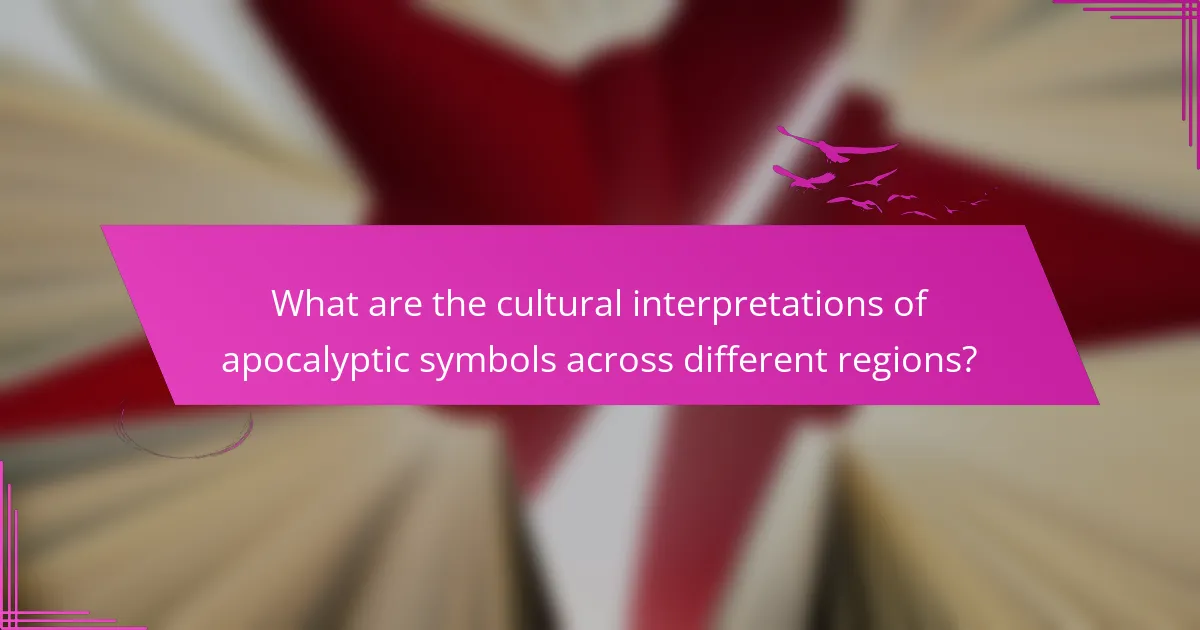
What are the cultural interpretations of apocalyptic symbols across different regions?
Cultural interpretations of apocalyptic symbols vary significantly across regions, reflecting unique historical and social contexts. In Western cultures, symbols often represent divine judgment and moral reckoning, while Eastern interpretations may focus on cyclical renewal and rebirth.
For example, the imagery of fire and destruction in Western literature signifies purification and the end of an era. In contrast, similar symbols in Eastern texts, like the phoenix, embody transformation and hope.
Additionally, indigenous cultures may interpret apocalyptic symbols as warnings from nature, emphasizing the need for harmony with the environment. These diverse meanings illustrate how symbolism in apocalyptic fiction resonates differently based on cultural lenses and collective experiences.
How do North American apocalyptic stories reflect societal fears?
North American apocalyptic stories often symbolize societal fears, reflecting anxieties about technology, climate change, and societal collapse. These narratives serve as mirrors, revealing deep-seated concerns about the future.
For example, in many stories, technology represents both progress and peril. Characters grapple with the consequences of innovation, illustrating fears of losing control over human creations. Climate change is another prevalent theme, where environmental disasters symbolize the consequences of neglecting nature.
Additionally, societal collapse often manifests through depictions of isolation and distrust among individuals. These portrayals resonate with contemporary issues, such as political polarization and social fragmentation.
Overall, the use of symbolism in apocalyptic fiction allows for nuanced interpretations of modern anxieties, making these stories relevant and thought-provoking.
Which symbols resonate more in European apocalyptic literature?
Symbols in European apocalyptic literature often include the four horsemen, darkness, and the number 666. These symbols represent chaos, destruction, and the end of times. The four horsemen symbolize conquest, war, famine, and death, embodying societal fears. Darkness signifies ignorance and despair, while 666 denotes evil and impending doom. Each symbol serves to deepen the narrative’s exploration of human existence and morality in a time of crisis.

What role does character symbolism play in apocalyptic fiction?
Character symbolism in apocalyptic fiction serves to convey deeper meanings and themes. Characters often represent broader concepts such as hope, despair, or humanity’s resilience. For instance, a lone survivor may symbolize the struggle against overwhelming odds, highlighting themes of isolation and perseverance. Additionally, the use of symbolic characters can reflect societal fears or moral dilemmas, enriching the narrative and prompting readers to contemplate their own values. This layered symbolism enhances the emotional impact of the story and invites diverse interpretations.
How do protagonists embody specific symbolic meanings?
Protagonists in apocalyptic fiction often embody symbolic meanings that reflect societal fears and hopes. Their journeys represent resilience, morality, and the struggle for survival against overwhelming odds. For example, a character may symbolize hope through their actions, inspiring others to persevere. Unique attributes, such as personal backstories, deepen these symbolic representations, allowing readers to connect on emotional levels. Additionally, rare traits, like unconventional leadership styles, can challenge traditional narratives, offering fresh interpretations of heroism in dire circumstances.
What is the significance of antagonists as symbols of societal issues?
Antagonists in apocalyptic fiction symbolize societal issues by embodying fears and conflicts within communities. They represent the breakdown of moral values, reflecting societal anxieties regarding power, survival, and ethics. For instance, a tyrannical leader in such narratives often symbolizes government oppression, illustrating the struggle against authoritarianism. Additionally, environmental disasters as antagonistic forces highlight humanity’s neglect of nature, prompting discussions on climate change. These symbols provoke critical reflection on contemporary societal challenges, making them significant in understanding human behavior and societal dynamics.
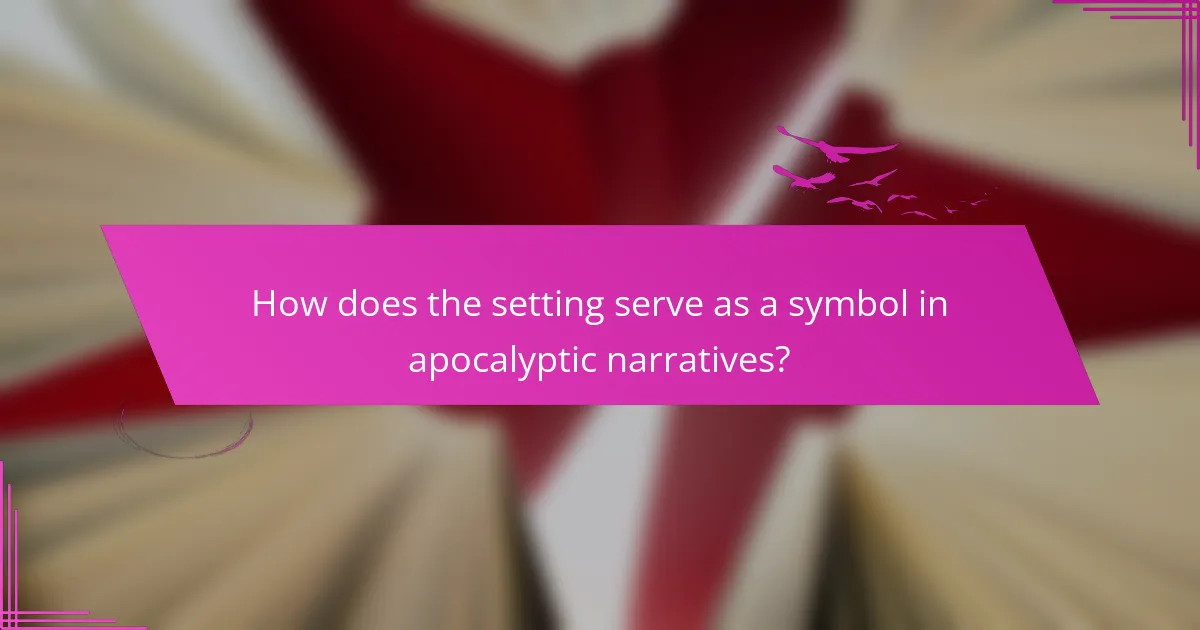
How does the setting serve as a symbol in apocalyptic narratives?
The setting in apocalyptic narratives often symbolizes societal collapse, human fragility, and existential dread. It reflects the characters’ emotional states and amplifies themes of survival and hope. For instance, desolate landscapes can represent loss, while remnants of civilization may evoke nostalgia. This duality enhances the narrative’s depth, allowing readers to explore complex interpretations of humanity’s future.
Which landscapes are commonly used as symbols and what do they represent?
Common landscapes used as symbols in apocalyptic fiction include barren deserts, flooded cities, and decaying urban environments. These landscapes represent desolation, loss of civilization, and the consequences of environmental collapse. For example, barren deserts symbolize hopelessness and the struggle for survival. Flooded cities often depict the overwhelming power of nature and human vulnerability. Decaying urban environments highlight the decline of society and the remnants of human achievement. Each landscape serves to enhance the themes of despair and resilience in the narrative.
How does urban decay symbolize societal collapse?
Urban decay symbolizes societal collapse by illustrating the deterioration of urban environments and the loss of community. This imagery reflects broader themes of neglect, disillusionment, and the consequences of unchecked progress. In apocalyptic fiction, decaying landscapes often serve as a backdrop for exploring human resilience amidst chaos. Such settings evoke feelings of despair while prompting reflections on societal values and priorities. Urban decay, as a unique attribute, highlights the stark contrast between past vibrancy and present decay, reinforcing the narrative of collapse.
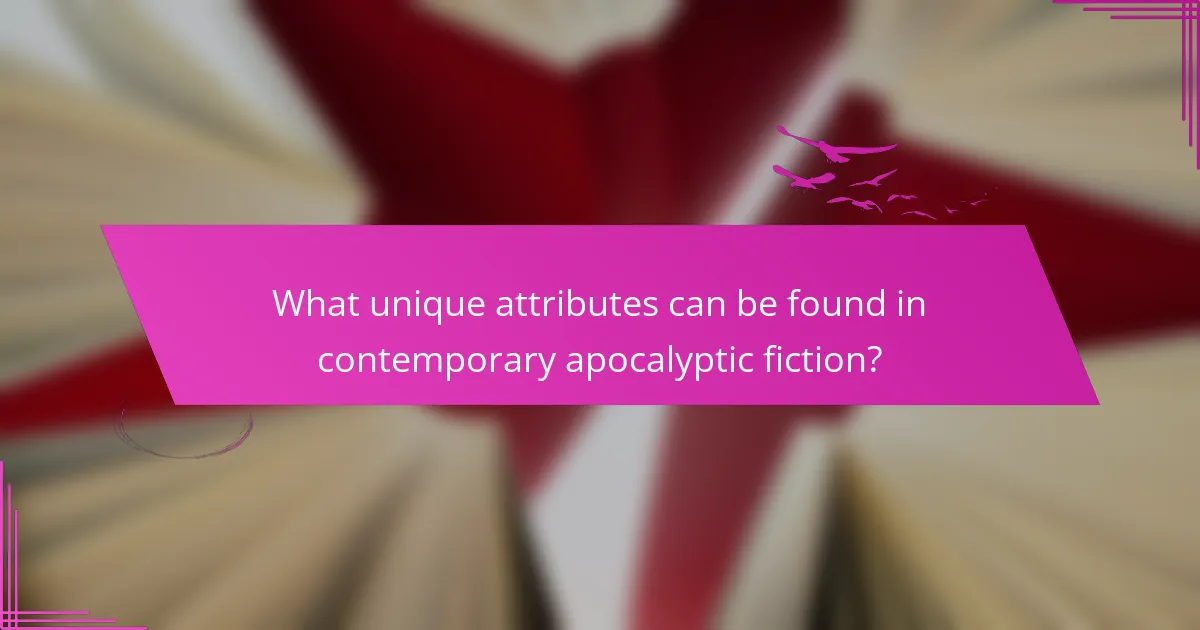
What unique attributes can be found in contemporary apocalyptic fiction?
Contemporary apocalyptic fiction often features unique attributes that deepen its thematic richness. Symbolism plays a crucial role, allowing authors to convey complex meanings through imagery and metaphor. For instance, the use of natural disasters may symbolize societal collapse or human hubris. Additionally, characters often embody archetypes, such as the reluctant hero or the tyrannical leader, representing broader human experiences and moral dilemmas. Rarely, some narratives incorporate technology as a symbol of both salvation and destruction, highlighting the duality of human innovation. These elements collectively create a multifaceted exploration of existential themes.
How do modern authors reinterpret classical symbols?
Modern authors reinterpret classical symbols by infusing them with contemporary meanings and relevance. They often explore themes of existentialism, environmentalism, and social justice through these symbols. For instance, the use of the apocalypse as a symbol can reflect societal anxieties about climate change and technological advancement. This recontextualization allows readers to connect with age-old symbols in a new light, enhancing their impact and resonance. As a result, classical symbols gain renewed significance in apocalyptic fiction, bridging historical context with modern concerns.
Which emerging symbols reflect current global challenges?
Emerging symbols in apocalyptic fiction reflect global challenges such as climate change, social inequality, and technological dependence. These symbols often serve as metaphors for societal fears and aspirations. For instance, the depiction of dystopian landscapes signifies environmental degradation, while characters representing marginalized groups highlight social disparities. Additionally, advanced technology in these narratives can symbolize both progress and potential loss of humanity. As a result, these symbols resonate with contemporary audiences, prompting reflection on real-world issues.
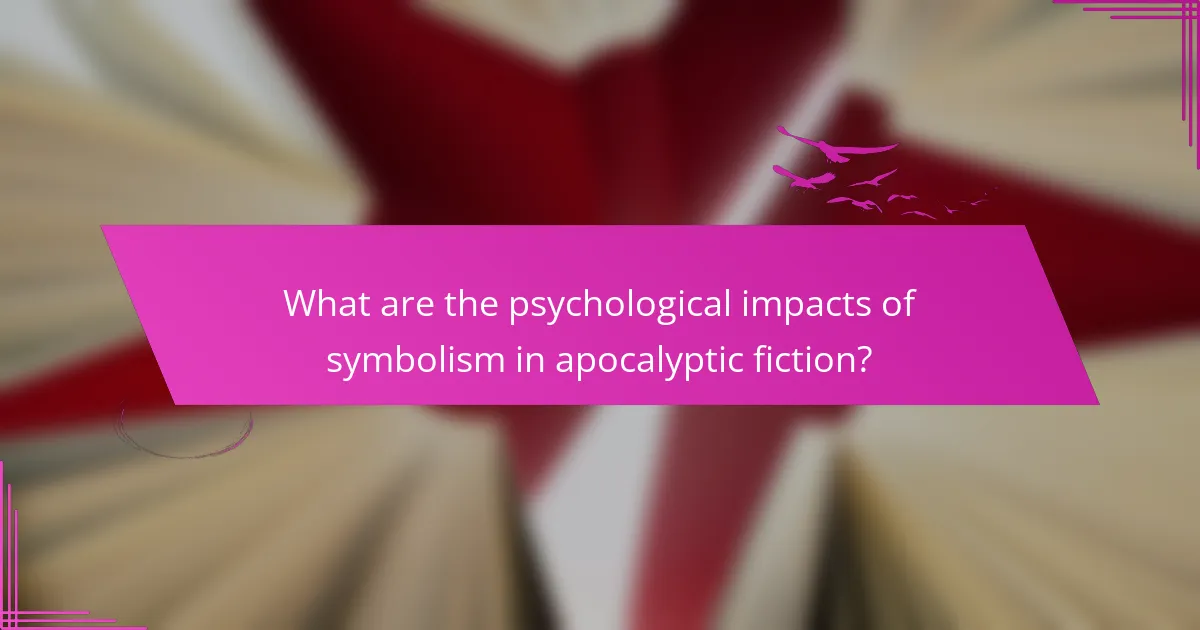
What are the psychological impacts of symbolism in apocalyptic fiction?
Symbolism in apocalyptic fiction profoundly influences psychological responses, fostering feelings of anxiety and existential reflection. Symbols often represent societal fears, such as climate change or nuclear war, heightening emotional engagement. This genre encourages readers to confront their fears through metaphorical narratives, allowing for catharsis and deeper understanding of human resilience. As a result, the use of symbolism not only enriches the story but also facilitates personal introspection and societal critique.
How do symbols evoke emotional responses in readers?
Symbols evoke emotional responses in readers by creating deeper connections to themes and characters. In apocalyptic fiction, symbols often represent hope, despair, or survival. For instance, a crumbling city can symbolize lost civilization, while a lone tree may signify resilience. These symbols resonate emotionally, enhancing the reader’s experience and engagement with the narrative. By tapping into universal themes, authors can evoke feelings of nostalgia, fear, or inspiration, making the story more impactful.
What is the role of symbolism in shaping reader perceptions of reality?
Symbolism in apocalyptic fiction profoundly shapes reader perceptions of reality by conveying complex themes and emotions. Through symbols, authors express societal fears, moral dilemmas, and existential questions, allowing readers to interpret deeper meanings. For instance, the use of barren landscapes often symbolizes loss and desolation, reflecting inner turmoil. Additionally, recurring motifs, such as the struggle for survival, highlight resilience and hope amidst chaos. This layered approach fosters a connection between the narrative and the reader’s own experiences, enhancing the overall impact of the story.
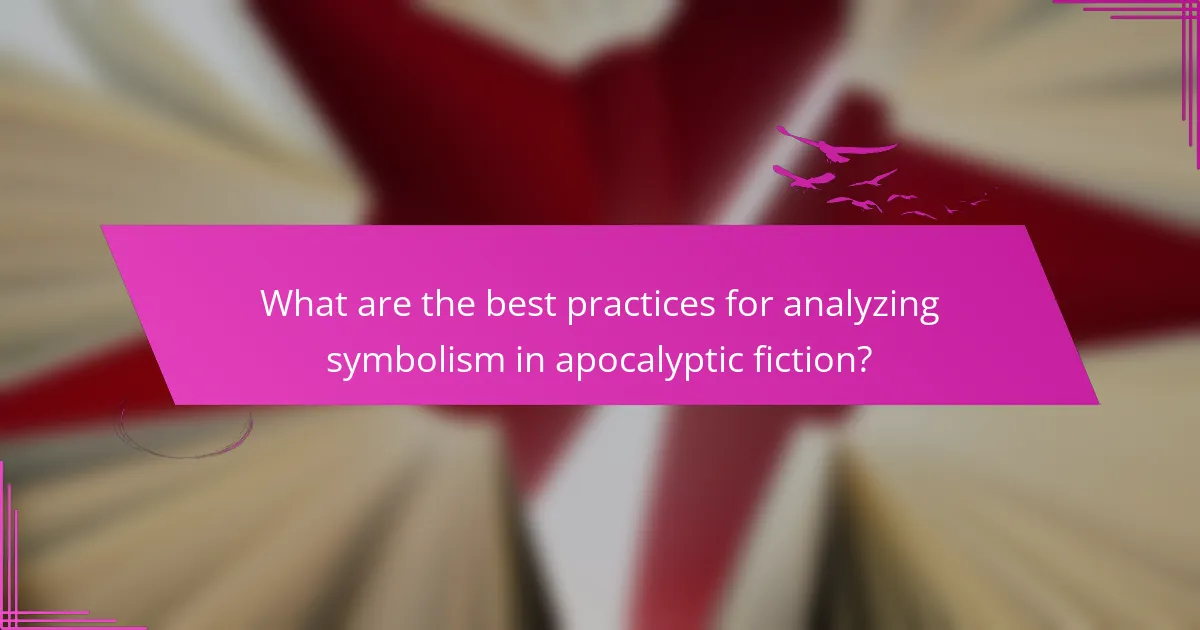
What are the best practices for analyzing symbolism in apocalyptic fiction?
To analyze symbolism in apocalyptic fiction effectively, focus on thematic elements, character representations, and societal critiques. Examine how symbols reflect fears, hopes, and moral dilemmas. Explore recurring motifs like destruction, survival, and rebirth to uncover deeper meanings. Consider the author’s intent and cultural context to enrich interpretations. Analyze how unique symbols differentiate narratives and engage readers on multiple levels.
How can readers identify and interpret symbols effectively?
Readers can identify and interpret symbols effectively by analyzing their context and significance within the narrative. In apocalyptic fiction, symbols often represent broader themes such as survival, humanity, and morality. Recognizing recurring motifs, such as desolation or rebirth, enhances understanding. Additionally, examining character interactions with these symbols can reveal deeper meanings. Engaging with critical analyses or discussions can also provide diverse interpretations, enriching the reading experience.
What common mistakes should be avoided when analyzing symbolism?
Common mistakes to avoid when analyzing symbolism include overgeneralizing meanings, ignoring context, and neglecting character perspectives. Focus on the specific narrative and thematic elements that shape symbolism in apocalyptic fiction. Misinterpreting symbols can lead to flawed analyses. Additionally, failing to consider cultural and historical backgrounds may result in incomplete interpretations. Recognizing these pitfalls enhances understanding of deeper meanings and enriches literary discussions.
